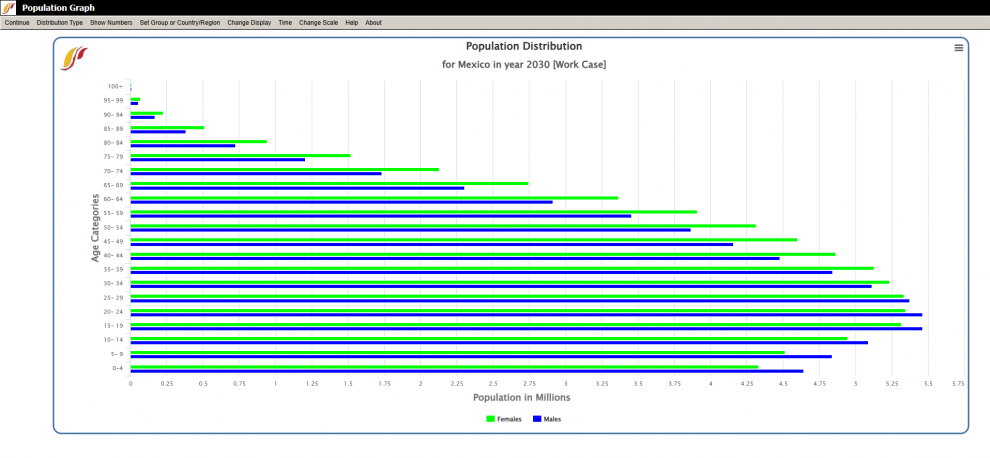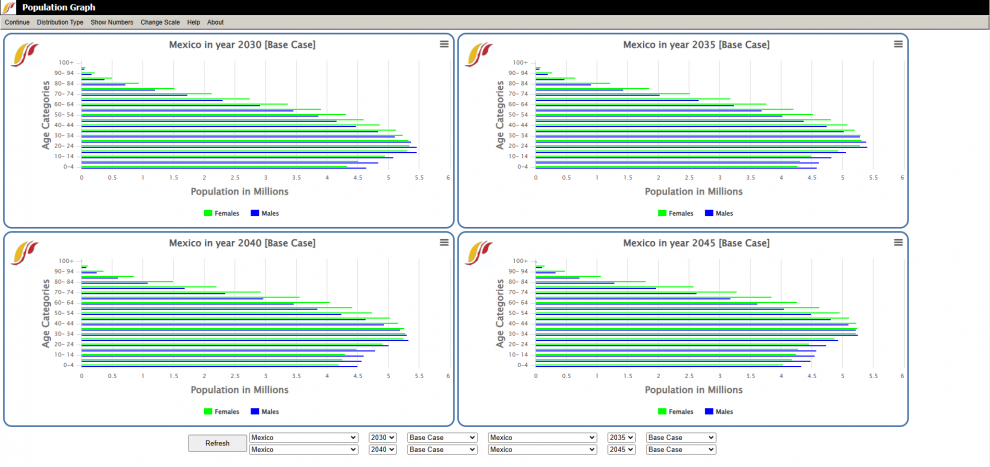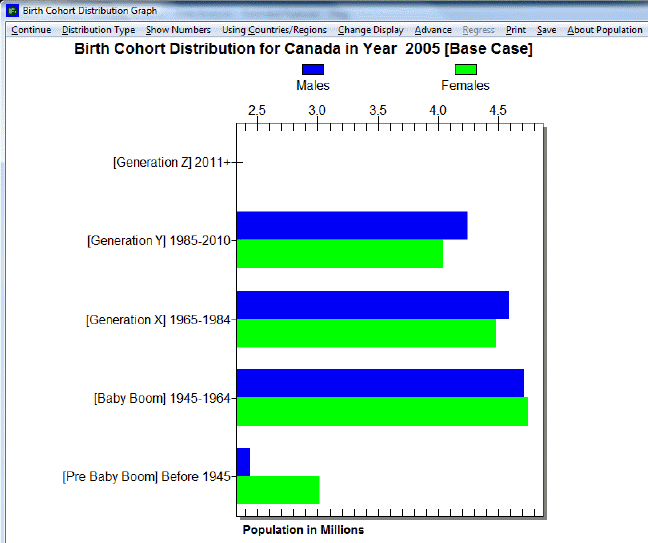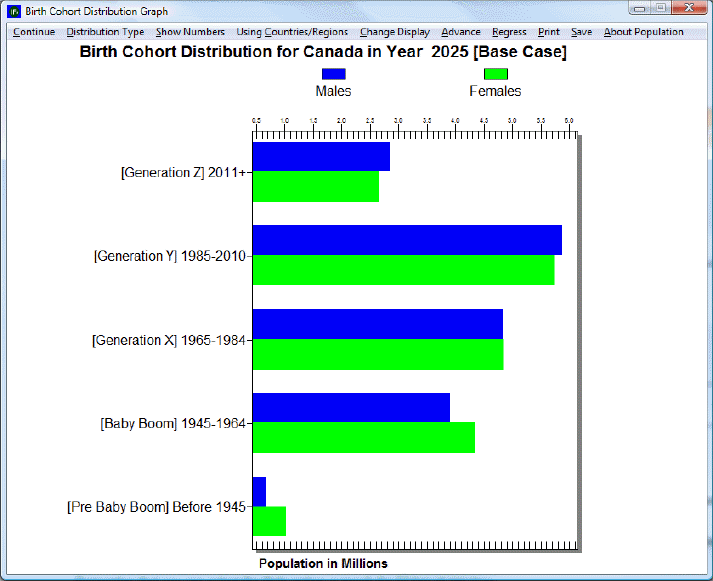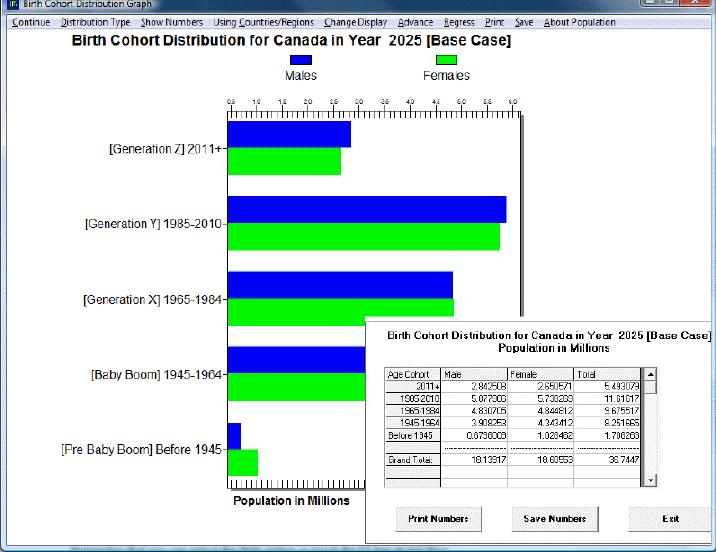Use IFs (Download): Population: Difference between revisions
No edit summary |
|||
| (9 intermediate revisions by the same user not shown) | |||
| Line 1: | Line 1: | ||
= <span style="font-size:xx-large;">Population by Age and Sex</span> = | == <span style="font-size:xx-large;">Population by Age and Sex</span> == | ||
The Population by Age and Sex option can be found from the Main Menu: choose the Display option, the Specialized Displays sub-option, and the Population by Age and Sex sub-sub-option. The option is also found in the [[Main Menu Map]] options. | |||
That will bring up an age-sex distribution of population, like the one below for Mexico in 2030. From this display there are several features and options that can be accessed using the menu bar at the top of the screen.[[File:Mexico Population Graph 2030.png|alt=A graph of Mexico's population distribution with 5 year age cohorts in the year 2030 takes up most of the screen. On the top of the screen image are the different options explained in this section.|center|990x990px|thumb|An example of what the Population by Age and Sex Screen will open to when accessed from the Main Menu. Includes a population distribution graph for Mexico, and the options for this special display at the top.]]These options and features include: | |||
* [[Repeated Features#General Display Options|Continue]]: To go back to the previous menu or to the Main Menu of IFs. | |||
* Distribution Type: Allows users to select other types of population charts to be displayed through clicking on one of the following sub-options. | |||
** Age Distribution: Displays an age-sex distribution chart like the one shown above for Mexico. | |||
** Fertility Distribution: Displays a chart that shows at what age women are having children. | |||
** Mortality Distribution: Displays a chart of mortality rate for each age cohort. | |||
** Population Pyramid: Displays a chart that separates the population into sexes (males on the left, females on the right) and age cohorts in 5 year intervals. | |||
** Compare Countries: Allows users to compare four charts for different countries years or scenarios, or any combination of the three. This option will initially bring up four charts for the country and distribution type most recently displayed for the next four 5-year increments for example 2030, 2035, 2040, and 2045. An example of this display option is shown below for Mexico. | |||
* Show Numbers: Displays the numbers that were used to create the current chart being viewed. | |||
* Set Group or Country/Region: Allows users to change between displaying either country/region or groups by clicking on either Group or Country/Region sub-options. The selection for the current chart being displayed will have a checkmark next to it. | |||
* Change Display: Allows users to display a population chart for any country or group, scenario, or year in IFs by hovering over any of the three sub-options. | |||
** Change Countries/Regions: A list will appear and users can scroll down and then click on the country or group of their choice. | |||
** Set Year: A list of available years to display will appear; users can click on their desired year. | |||
** Change Scenario: Allows users to display the results from the base case or any other saved scenario runs by clicking the desired scenario. | |||
* Time: Hovering over Time will bring up two sub-options. | |||
** Advance: Users can click on this sub-option to move the chart forward 5 years. | |||
** Regress: Users can click on this sub-option to move the chart backwards 5 years. | |||
* Change Scale: Brings up four sub-options on varying ways to adjust the scaling of population charts. | |||
** Fix Constant Scale across Time and Regions: Sets a constant scale for the Population, Fertility, and Mortality (X) axis across all years and across all countries or groups. | |||
** Fix Constant Scale across Time: Sets a constant scale for the Population, Fertility, and Mortality (X) axis across all years for the currently selected country or group. | |||
** Fix Constant Scale Manually: Allows the user to set the maximum value to be displayed for Population, Fertility, and Mortality. | |||
** Use Percent of Population: Adjusts the x-ais to display percent of Population and no longer the count. | |||
* Help: Brings the user to the corresponding page in the [[Main Page|Pardee Wiki]] with the current feature or display they are on. | |||
* About:<div style="color: red; font-weight: bold;">Feature is no longer available or outdated in the model. </div> | |||
[[File:Mexico Comparison 2030.png|alt=Four graphs make up most of the screen. Each graph shows a different year of Mexico's age distribution in 5 year increments, from 2030 to 2045. At the top of the screen in the tools bar with the Continue, Distribution Type, Show Numbers, Change Scale, Help, and About tabs. At the bottom of the screen is a large refresh button and options to change the country year and scenario of each of the four graphs displayed.|center|thumb|990x990px|Shows an example of what the screen looks like when a user first clicks on the Compare Countries sub option under the Distribution Type option when using the Population by Age and Sex Specialized Display.]] | |||
At the bottom of the compare countries screen users can select which country, year, and scenario that they desire to display for each of the four graphs; after adjusting click Refresh to change the displays. To switch to a different type of population chart to compare, a user can click Distribution Type form the menu bar and click the desired distribution. | |||
In the interest of transparency, IFs presents [[Population#Dominant_Relations:_Population|information]] about population data and equations that are used to determine these numbers. | In the interest of transparency, IFs presents [[Population#Dominant_Relations:_Population|information]] about population data and equations that are used to determine these numbers. | ||
==<span style="font-size:xx-large;">Birth Cohort Information</span>== | |||
= <span style="font-size:xx-large;">Birth Cohort Information</span> = | |||
The feature Birth Cohort Information is located under the Specialized Display suboption, which is in turn located under the Display topic on the Main Menu. | The feature Birth Cohort Information is located under the Specialized Display suboption, which is in turn located under the Display topic on the Main Menu. | ||
Latest revision as of 19:18, 4 February 2025
Population by Age and Sex
The Population by Age and Sex option can be found from the Main Menu: choose the Display option, the Specialized Displays sub-option, and the Population by Age and Sex sub-sub-option. The option is also found in the Main Menu Map options.
That will bring up an age-sex distribution of population, like the one below for Mexico in 2030. From this display there are several features and options that can be accessed using the menu bar at the top of the screen.
These options and features include:
- Continue: To go back to the previous menu or to the Main Menu of IFs.
- Distribution Type: Allows users to select other types of population charts to be displayed through clicking on one of the following sub-options.
- Age Distribution: Displays an age-sex distribution chart like the one shown above for Mexico.
- Fertility Distribution: Displays a chart that shows at what age women are having children.
- Mortality Distribution: Displays a chart of mortality rate for each age cohort.
- Population Pyramid: Displays a chart that separates the population into sexes (males on the left, females on the right) and age cohorts in 5 year intervals.
- Compare Countries: Allows users to compare four charts for different countries years or scenarios, or any combination of the three. This option will initially bring up four charts for the country and distribution type most recently displayed for the next four 5-year increments for example 2030, 2035, 2040, and 2045. An example of this display option is shown below for Mexico.
- Show Numbers: Displays the numbers that were used to create the current chart being viewed.
- Set Group or Country/Region: Allows users to change between displaying either country/region or groups by clicking on either Group or Country/Region sub-options. The selection for the current chart being displayed will have a checkmark next to it.
- Change Display: Allows users to display a population chart for any country or group, scenario, or year in IFs by hovering over any of the three sub-options.
- Change Countries/Regions: A list will appear and users can scroll down and then click on the country or group of their choice.
- Set Year: A list of available years to display will appear; users can click on their desired year.
- Change Scenario: Allows users to display the results from the base case or any other saved scenario runs by clicking the desired scenario.
- Time: Hovering over Time will bring up two sub-options.
- Advance: Users can click on this sub-option to move the chart forward 5 years.
- Regress: Users can click on this sub-option to move the chart backwards 5 years.
- Change Scale: Brings up four sub-options on varying ways to adjust the scaling of population charts.
- Fix Constant Scale across Time and Regions: Sets a constant scale for the Population, Fertility, and Mortality (X) axis across all years and across all countries or groups.
- Fix Constant Scale across Time: Sets a constant scale for the Population, Fertility, and Mortality (X) axis across all years for the currently selected country or group.
- Fix Constant Scale Manually: Allows the user to set the maximum value to be displayed for Population, Fertility, and Mortality.
- Use Percent of Population: Adjusts the x-ais to display percent of Population and no longer the count.
- Help: Brings the user to the corresponding page in the Pardee Wiki with the current feature or display they are on.
- About:Feature is no longer available or outdated in the model.
At the bottom of the compare countries screen users can select which country, year, and scenario that they desire to display for each of the four graphs; after adjusting click Refresh to change the displays. To switch to a different type of population chart to compare, a user can click Distribution Type form the menu bar and click the desired distribution.
In the interest of transparency, IFs presents information about population data and equations that are used to determine these numbers.
Birth Cohort Information
The feature Birth Cohort Information is located under the Specialized Display suboption, which is in turn located under the Display topic on the Main Menu.
The use of this feature is quite similar to the use of Cohorts of Population. However, this feature allows the user to view the total population of a country/region or group as broken down into generations. For example, notice the left side of the picture shown below. In this example, the birth cohorts are for Canada. For the year 2005, the majority of the population is grouped into Generations X and Y, which were born between the years 1965-1984 and 1985-2010 respectively, and the Baby Boom generation (1945-1964). A few of the Pre-Baby Boom generation is alive, while (obviously) no one from Generation Z is born yet.
Next, click on the Advance option on the top of the screen until year 2025 is reached, or click four times on the option. The user should see a graph similar to the one below. In this new graph, notice the changes in the distribution of the total population among the various generational cohorts. Members of Generation Z are now represented on the graph, while the numbers of the Pre-Baby Boom generation have decreased since 2005. The numbers of people belonging to the Baby Boom generation have also decreased, while the numbers for Generations X and Y seem to have changed little. To return the year to 2005 or any previous year, click on Regress in the heading.
The user is able to customize and experiment with the forecasted birth cohort information, according the preferences of the user. By clicking on the Show Numbers options in the heading, the user is able to view the number of males and females that makes up each generation. A dialogue box similar to the one shown below should appear. The user is able to save and/or print the birth cohort information.
If the user wants to change countries to view, first select Change Display, and then select Change Country/Region. A list of countries or regions to choose from should appear.
The year 2005 is displayed when the Birth Cohort option is first opened. Clicking on Advance or Regress will change the displayed year in five-year increments- from 2005 to 2010, from 2010 to 2015, and so on. To view a specific year, and to avoid having to click Advance multiple times to reach that year, simply select Set Year in the Change Display option in the heading. The user can select any year between 2005 and 2100.
The user may also be interested in view how the distribution of generational birth cohorts are affected by running scenarios different from the base case. To change the scenario, first select Change Display, and then Change Scenario.
